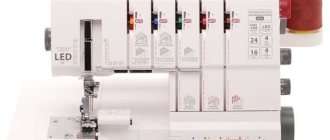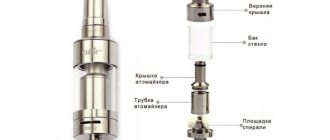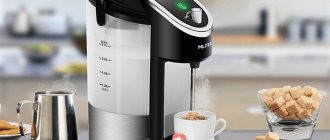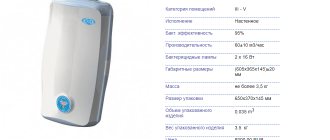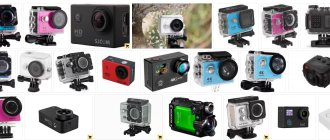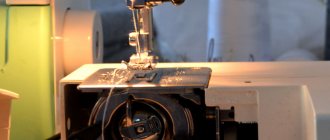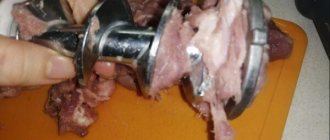When I had a need for high-quality processing of cuts, I wondered what kind of household machine I should buy. Nowadays there is a large selection of overlockers in stores, but it also turned out that there are machines superior to it in the number of jobs performed - these are overlockers. I didn’t know the difference between an overlocker and a carpetlocker, I wanted to buy it and not make a mistake.
Unfortunately, sellers in sewing equipment stores did not give me an accurate answer. Some said that you need to buy an overlocker and a coverstitch machine, because the coverlocker is too difficult to figure out. Others advised buying a carpet lock because it is multifunctional. Subsequently, I had to work on both machines and now I know what the difference is between them and for what work which machine is more suitable. So let's take it in order.
How are overlock and carpet similar?
Let's first look at the similarities between these two sewing machines.
- Despite the fundamentally different names of these sewing machines, they are similar in many ways, because the main function of an overlocker and a coverlocker is the same - high-quality processing of cuts, overcasting and prevention of fraying.
- Overlockers and coverlockers do not have the shuttle device that we are so accustomed to in a regular sewing machine. There is no need to constantly wind the thread onto the bobbin; all lower threading is carried out through loopers.
- The overlocker and coverlocker have a special knife that cuts off excess threads and makes the cut more accurate.
- What fabric can be sewn on an overlocker and carpet? Both of these devices are capable of high-quality work with elastic and highly stretchable fabrics, such as all types of knitwear, stretch fabrics, fabrics for sewing swimsuits and others. They also easily and efficiently seal sections on problematic, loose and very loose fabrics, such as linen, tweed, wool and coat fabrics.
It turns out that it doesn’t matter at all whether you buy an overlocker or a carpetlocker? Not quite so, friends, let's understand further, because despite the similar functionality, they have the same significant differences. This will be discussed further.
Functionality
As mentioned above, an overlocker is indispensable when processing and cutting the edges of fabric when performing sewing work. It is especially convenient to use this device when working with loose materials that do not have a dense structure. Tailors among themselves call them loose; it is always difficult to process them, but thanks to a special operating pattern, the overlocker copes with this.
Several threads of the device at once tightly hold the fabric section and overcast it very tightly, preventing the product from “scattering”. It is enough to just pass the fabric through the overlocker once to stitch the parts together efficiently, to stitch the cut tightly and reliably, and to remove excess fabric.
As for the carpet locker, it is also capable of performing the described operations well, and even more. The device successfully reproduces all the basic functions of an overlocker and a cover-stitching mechanism designed to work with knitted fabric. The carpet flawlessly processes the lower part of the piece, as well as the neck of the product.
Processing the neck of a knitted product
Rethreading
If you sit down to sew with an overlocker, then all that is required of you to change the threads is to cut off the previous ones and install new spools. There is no need to do any complex operations to reconfigure the internal mechanism. And some overlocker models provide automatic threading, which further simplifies the process of working with the overlocker.
In carpet, everything is different. If you need to change a stitch, you will have to take the instructions and delve into the structure of the machine, find out where the mode switches are, and carefully study its internal mechanism. Otherwise, if the settings are incorrect, your carpet locker will never make a quality stitch.
Complexity
If we compare these two devices in terms of the complexity of the work, then it is undoubtedly much easier to work with an overlocker, because its functionality does not have many additional lines, and all of them are aimed only at processing the edge, so the difference between them is only in the number of threads and weave.
Coverlock is capable of making more than twenty seams and not only those related to overcasting sections, but also other more complex ones - connecting seams consisting of five or more threads. Therefore, to work with a carpet locker, you will need more skills related to refilling and adjustment.
Best carpet
Elna 745
Elna works great with different numbers of threads - from 2 to 5. It makes excellent seams. Working speed – 1300 stitches per minute. There is a differential feed of the fabric, in which the edges of the knitwear do not stretch during sewing, and the slippery fabric does not move. The machine has 17 operations in its arsenal. The functionality is wide, among the important options of the machine:
- automatic refueling;
- tension control;
- switching off the knife;
- adjustment of material pressure and cutting width.
The set includes a foot pedal, a compartment for accessories and a tray for scraps. For convenience, there is an LCD display and color markings for correct threading. Compatible with 130/705 N needles (HAx1 SP). The maximum lifting height of the presser foot is 8 mm.
Pros:
- A large number of options;
- Good equipment;
- Automation;
- Touch control.
Cons: none.
Family MasterLock 9000D
This is a combination of two machines: a 5-thread overlocker and an electromechanical, 3-needle, 5-stitch flat-bed sewing machine. Can perform 20 operations. The tension is adjusted automatically, depending on the selected mode. The number of possible cover stitches is 3. They can be of different widths: 5 mm, 2.5 mm, triple.
The maximum sewing speed is 1300 stitches per minute. The needles and looper cannot be threaded manually. The front panel contains a stitch length regulator and a differential feeder. The program display shows the selected program number and recommended settings. The model is equipped with everything necessary: a puncture force stabilizer, a thread cutter, adjustment of the cutting width of the material and its pressure.
Pros:
- A large number of operations;
- Possibility of sewing with different numbers of threads – from 2 to 5;
- LCD display;
- Reliable Japanese assembly;
- Easy to refill;
- Rich equipment.
Minuses:
- Low price.
BabyLock Evolution BLE8W–2
Provides a stitch of 2 to 5 threads and can also be used as a sewing machine. Suitable for both home and professional use. According to the manufacturer, the machine can handle the roughest materials. Types of operations: rolled, cover stitch, chain stitch and flatlock. The maximum stitch length is 5 mm, the maximum stitch width is 7 mm. Presser foot pressure and thread tension can be adjusted. The differential conveyor makes it easier to work with knitted fabrics and slippery materials.
Types of adjustments: fabric cutting width and presser foot pressure. The set includes 3 feet: overlock, for cover stitch, for sewing on beads. In addition, there is an additional table, a tray for scraps and a soft fabric cover.
Pros:
- A large number of sewing operations - 20;
- Sewing coarse fabric in several layers;
- High sewing speed;
- Automation and LCD display;
- Good equipment;
- Reliable assembly and high quality work.
Minuses:
- At first, it is difficult to get used to threading.
Pfaff CoverLock 4852
The price-quality ratio of the model is one of the best. Essentially, this is a premium 2-5 thread overlocker and a high-quality 2.3-needle flat-stitch sewing machine. Differential feed and fast sewing ensure high productivity. The design provides for customization of stitch options, adjustable presser foot pressure and cutting width. Simple filling, 18 operations, a removable sleeve platform, a container for scraps and color markings make working with the carpet lock comfortable and not difficult.
Pros:
- Quiet operation;
- Easy operation and maintenance;
- Sharp knives and straight stitches;
- Lots of features.
Minuses:
- Not the easiest changeover to cover mode.
Janome 1200D
The combination of the functions of an overlocker and a flatbed sewing machine provides 20 different overcasting and flatbed edge processing options. With the help of modern technical capabilities, you can easily change it from 5 to 4, 3, 2 thread stitches. All processes are simplified and automated as much as possible. For the convenience of sewing, there is a setting of puncture force, tension control, and adjustment of fabric cutting parameters. Due to these characteristics, tailoring becomes simple and not labor-intensive. The machine processes the edges of thick jeans and weightless organza with the same quality.
Pros:
- Compact, easy to use;
- Perfectly performs lines;
- Quick reconfiguration for another operation;
- Works with all fabrics.
Minuses:
- A little noisy.
Singer 14T968DC
The German brand Singer has long established itself as one of the best manufacturers of sewing equipment. Coverlock 14T968DC is another successful product from this legendary brand. Its speed is high - 1300 stitches per minute. This allows you to use it for both home sewing and professional purposes. Easily copes with all types of seams: from rolled to flatlock. Performs 14 different operations efficiently. The differential conveyor makes sewing complex fabrics easier. Needles can be threaded manually or automatically.
Pros:
- Fast sewing speed;
- Reliable assembly.
Minuses:
- The foot does not rise too high - 5 mm. This prevents sewing thick fabrics into multiple hems.
Juki MO–735
The technical capabilities of the model allow you to perform 20 sewing operations. Due to the differential feed, the processed edge does not shrink and does not ripple. Automatic threading of the looper makes operation easier, and adjusting the presser foot and width ensures convenient operation of the unit. Stitch length – 1–4 mm, width 2–10 mm. The presser foot lifts up to a maximum of 6 mm, which makes it possible to stitch through thick layers of material. Maximum speed – 1500 stitches per minute.
Pros:
- Wide technical capabilities;
- Convenient refueling;
- Not too noisy;
- High quality sewing;
- Can process various types of fabric.
Minuses:
- Loose fastening of the “pocket” for collecting scraps.
Merrylock 5550A
Ideal for use at home. The machine makes 20 stitch options. At the same time, it works quite quickly - up to 1300 stitches per minute. The tension can be adjusted independently or using automation. Differential feed allows you to process even the most capricious fabrics with high quality. The main characteristics correspond to the standards of industrial machines, therefore they provide improved quality for household sewing.
Pros:
- Smooth running, easy switching to another operation;
- Simple refilling system with color schematic prompt;
- Clear instructions;
- High-quality stitches;
- Wide functionality.
Minuses:
- Difficulties in sewing too thick materials due to the slight lift of the presser foot.
Aurora 5000D
The 5000D model can make 20 different stitches. It will automatically monitor the tension and ensure fast operation at the level of industrial sewing machines. Color schemes of programs are drawn on the panel. Therefore, you won’t have to ask for instructions every time. The package includes a standard set that will provide ease of sewing. The work surface is illuminated by two LED lamps. Setting the presser foot pressure and adjusting the stitch width will help you easily adjust the machine to the required sewing mode.
Pros:
- Easy to refill;
- 1300 stitches/minute;
- Automatic tension;
- Smooth and varied stitches;
- Good quality for a household machine.
Minuses:
- No gas station.
Leader VS 390D
An excellent choice for those who want to get a high-quality cover stitching machine and overlocker in one product for little money. The model is well suited for household purposes; it performs 20 operations at a maximum speed of 1300 stitches per minute. The differential conveyor ensures uniform feeding of the web. Thanks to this, the stitching does not worry, it turns out even and of high quality. The VS 390D has a high presser foot lift. This allows you to sew thick fabrics.
Pros:
- Does not make noise, makes uniform stitches and straight lines;
- Good functionality at a reasonable price.
Minuses:
- There is no auto-tensioning or threading.
Number of loopers
If you look into the internal structure of these machines, you will see that the number of loopers for an overlocker is two, and for a carpet locker there are three. Who are these loopers and why are they needed? A looper is a pointed metal piece that looks like a hook with an eye for threading through the end. The looper is capable of interlocking threads with each other and making complex chain stitches that are used to sew overlock and carpet stitching. Externally, the chain stitch resembles a braided braid. The more loopers a sewing machine has, the more sewing operations it can perform.
How does a carpet differ from an overlock?
Before talking about the differences between the two sewing machines, it’s worth talking a little about how they are similar. They have one common part - a looper. By the way, cover covers like the CoverPro 1000CP cannot do without this element. It is thanks to this that the devices do not need a bobbin with which to wind the lower thread. In such machines, it is tucked into the looper and fed directly from the reel.
And here is the first difference. It depends on the number of loopers. The carpetlock has two of them. This gives him the ability to perform a chain seam. A carpet locker differs from an overlock machine in that it has greater functionality. He knows how to make overlock, chain and flat - cover - seams. There is also a difference in price. Because the overlocker has fewer skills, it costs less than the overlock sewing machine. However, one carpet locker will certainly not be more expensive than buying both a cover stitcher and an overlocker.
Interesting : the chain stitch is similar to a pigtail. It is used for sewing knitwear, jeans, and stretch. Such stitches are strong, highly extensible, and therefore are used for sewing sportswear.
See also: How to choose a sewing machine?
The difference between an overlocker and a carpetlocker is the capabilities. The second version of the device can make more diverse seams. With its help, you can overcast and trim fabric, make chain and cover stitches. An overlocker has more limited capabilities. It is not capable of a flat seam like a cover stitch. Which option to take depends on your needs. If you want multifunctionality, then a carpet lock is the best choice. Those who sew from time to time or own a regular and cover sewing machine should take a closer look at an overlocker. Such a device will be cheaper.
The length of the sleeve
If you look visually at an overlocker and a carpetlocker, you can immediately notice a significant difference in the shape of these sewing machines. In an overlocker there is practically no space left on the inside of the foot, while a overlocker has additional space for the length of the sleeve overhang. It is needed for making knitted stitches when you need to join parts, and not just overcast the edges.
Versatility
If you are considering the purchase of sewing equipment in order to only overcast sections, then of course you do not need an overlocker; one overlocker will be enough for you. But if you often sew knitted items, then it is better to consider a carpet for purchase. Some people think about buying two machines at once - an overlocker and a cover-stitching machine, but in this case I advise you to take a coverlock, so firstly you will save space, and secondly, money, because a carpetlock is a universal sewing technique that combines functionality two cars.
The main purpose
Overlock, perhaps a familiar word to everyone, is a technique that, according to its purpose, is designed to overcast fabric, and at the same time, while working, cuts off excess strips of fabric. It is simply an irreplaceable thing for professional sewing, and having one in your home arsenal for amateur sewing is a great luxury. After all, with its help you can achieve high-quality tailoring. It is suitable for sewing various types of fabrics and textiles.
Overlock is also essentially the same overlock, only with expanded capabilities. A coverlock can be called a combination of an overlocker and a cover stitching machine. It is capable of sewing almost all types of fabrics. And its main difference is that it can easily handle knitwear. That is, this is the feature through which it is dominant over overlock.
Thanks to its special function, it easily overcasts knitted fabrics by applying a smooth, flat (cover) seam. This feature gives it a great advantage, since the use of elastic, knitted fabrics in the process of making various products is very common.
Repair
If the overlocker breaks down, you will not have problems with repairs; any sewing technician can easily set up the overlocker and replace worn parts. With carpet, the situation is a little more complicated. Since this is a fairly new invention, the craftsmen are not yet particularly versed in repairing carpet locks. Finding a good repairman to repair a carpet will take time. It will also take a lot of effort to search for broken parts; they may not be available in your city and you will have to order them online, which will also take time.
Price
When you look at the prices in stores for both of these sewing devices, you will see that the simplest three-thread overlock can be purchased from three thousand rubles, while a carpet lock costs three or even five times more. And in order not to be unfounded, you can go to any website of a large supplier of sewing products yourself and check the prices for these two types of sewing equipment. By the way, if you decide to buy a carpet and don’t want to bother with the choice, I advise you to do it in the same store. All questions are answered professionally and quickly.
What machine do I use at home now?
I have a Merrylock carpet in my home workshop. Why did I choose the carpet? I primarily proceeded from my sewing needs. Since I have to sew a lot from knitwear, we can say that it makes up almost 70% of all the fabrics with which I work, then of course I simply needed a machine that would perform all the knitted seams.
At first it was really difficult for me to get used to constantly switching modes; I sat with my nose buried in the instructions, trying to understand the intricacies of threading my carpet. But when you sew a lot and for a long time, this stage no longer seems like a problem. Now I'm tucking my carpet with my eyes closed)
Online cutting and sewing courses for beginners video - lessons
If you purchased an overlocker or a carpet locker and don’t know where to start, I have online cutting and sewing courses for beginners:
1) Design - this course is suitable for those who want to learn how to create patterns and take measurements of a figure. To successfully pass here you do not need to be an ace in drawing or have any special skills, the information is presented easily and simply
2) A basic course in cutting and sewing is the basics. I suggest taking it to all beginners who are in search of sewing knowledge and don’t know where to start. This course was pieced together from my offline (live) sewing courses, which I have been teaching in the city of Ufa since 2014. I know at what stage students may have difficulties, so I can help you
3) Course on sewing pajamas and underwear This course was born in the process of working on master classes on home clothes, when I saw that my interest in it deserves separate training. In this course we sew using ready-made patterns, so it is perfect for complete beginners who are still afraid to delve into the processes of constructing patterns. Honestly, you can even take this course with your children, because it is interesting, and you can get results very quickly!
Disadvantages of carpeting
It would seem how such an effective device could have drawbacks. However, no technique is perfect. Therefore, if there is an advantage in one thing, then in another they will certainly find at least minor, but disadvantages. Let's call them:
- High price. So, the cost of a carpet lock is really much higher compared to an overlocker. Moreover, at this price you can purchase two independent pieces of equipment, for example, an overlocker and a cover-stitching machine, and they sometimes cost less than a carpetlocker.
- Complex operating principle. Despite the achievements, working on such a device is quite difficult. First you need to understand it well, and then work it out in practice. Especially working with knitwear requires fairly quick maneuvers with gear changes. It should be noted that even experts in sewing technology admit the operating principle is complex.
- Heavy weight. Modern carpet locks can be improved with a number of new processes and mechanisms, which is why its weight will be quite large. All these additional functions are sometimes not even used during operation, but significantly complicate the process of setting up the device and operating it.
We looked at how overlockers differ from coverlocks based on their main characteristics and we can draw certain conclusions. It is impossible to say for sure which device is better from both. Probably, you should choose from the needs, capabilities and wishes for such a unit. The main thing is to correctly navigate the properties and main functions of technology, and based on this, make the right choice. Your own right choice.
